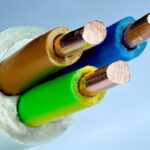Intrinsic Semiconductor
Semiconductors can be intrinsic or extrinsic. Intrinsic means that electrical conductivity does not depend on impurities, thus intrinsic means pure. In extrinsic semiconductors the conductivity depends on the concentration of impurities. Conduction is by electrons and holes. In an electric field, electrons and holes move in opposite direction because they have opposite charges.
In an intrinsic semiconductor, a hole is produced by the promotion of each electron to the
conduction band. Thus:
n = p
Extrinsic Semiconductor
Unlike intrinsic semiconductors, an extrinsic semiconductor may have different concentrations of holes and electrons. It is called p-type if p>n and n-type if n>p. They are made by doping, the addition of a very small concentration of impurity atoms. Two common methods of doping are diffusion and ion implantation. Excess electron carriers are produced by substitutional impurities that have more valence electron per atom than the semiconductor matrix. For instance phosphorous, with 5 valence electrons, is an electron donor in Si since only 4 electrons are used to bondto the Si lattice when it substitutes for a Si atom. Thus, elements in columns V and VI of the periodic table are donors for semiconductors in the IV column, Si and Ge. The energy level of the donor state is close to the conduction band, so that the electron is promoted (ionized) easily at room temperature, leaving a hole (the ionized donor) behind. Since this hole is unlike a hole in the matrix, it does not move easily by capturing electrons from adjacent atoms. This means that the conduction occurs mainly by the donated electrons (thus n-type). Excess holes are produced by substitutional impurities that have fewer valence electrons per atom than the matrix. This is the case of elements of group II and III in column IV semiconductors, like B in Si. The bond with the neighbors is incomplete and so they can capture or accept electrons from adjacent silicon atoms. They are called acceptors. The energy level of the acceptor is close to the valence band, so that an electron may easily hop from the valence band to complete the bond leaving a hole behind. This means that conduction occurs mainly by the holes (thus p-type).
The Temperature Variation of Conductivity and Carrier Concentration
Temperature causes electrons to be promoted to the conduction band and from donor levels, or holes to acceptor levels. The dependence of conductivity on temperature is like other thermally
activated processes:
σ = A exp(–Eg/2kT)
where A is a constant (the mobility varies much more slowly with temperature). Plotting ln σ vs.
1/T produces a straight line of slope Eg/2k from which the band gap energy can be determined. Extrinsic semiconductors have, in addition to this dependence, one due to the thermal promotion of electrons from donor levels or holes from acceptor levels. The dependence on temperature is also exponential but it eventually saturates at high temperatures where all the donors are emptied or all the acceptors are filled. This means that at low temperatures, extrinsic semiconductors have larger conductivity than intrinsic semiconductors. At high temperatures, both the impurity levels and valence electrons are ionized, but since the impurities are very low in number and they are exhausted, eventually the behavior is dominated by the intrinsic type of conductivity.

Intrinsic semiconductor

Extrinsic semiconductor


